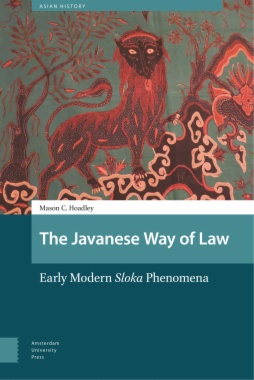The author's investigation of early-modern Javanese law reveals that judicial authority does not come from the contents of legal titles or juridical texts, but from legal maxims and variations thereof. A century and a half ago Simon Keyzer, a recognized scholar of Javanese law, noted that understanding of that law is dependent upon a grasp of such pithy expressions, which provide the key to the whole body of suits. (Preface, C.F. Winter, Javaansche Zamenspraken, 1858, which examines hundreds of sloka, the majority of which are directed to prevailing legal practice). Drawing upon the contents of 18th century Javanese legal texts, the present work builds upon Keyzer's and Winter's references to 'sloka-phenomena', namely sloka proper (maxims) and its derivatives sinalokan (that made of sloka), aksara here meaning legal principles, and prakara (matter, case). These are usually conveyed in vignettes illustrating their function and as a group, constitute the essence of traditional Javanese written law.
- Cover
- Table of Contents
- Section I: Law, Sloka, and Sources
- 1. Traditional Law. Sloka in Pepakem
- Javanese written law
- Legal texts as pepakem
- Generic pepakem and the Pepakem Cirebon of 1768
- 2. Sloka in Javanese Titles
- Manuscripts v. titles
- Titles of the Sloka phenomena
- Sloka
- Slokantara tradition
- Jimbun Slokantara
- Combi Slokantara, Raja Niscaya, Wadigun Wangkara
- Jugul Muda tradition
- The Surya Alam challenge
- The Kartasura Surya Alam and the van der Hout translation
- Aksara
- Sinalokan
- Luwangan
- Didactic sinalokan
- Prakara
- The Yogyakarta/Combi Surya Alam
- Summary
- Section II: Sloka Phenomena in Vignettes
- 3. Sloka
- Substance of a sloka
- The second vignette
- Interpretation
- Verbal symbols
- Sloka ratu
- Sloka authority to punish
- Conclusion
- 4. Aksara
- Origins
- Aksara in the Jaya Lengkara
- Aksara modes
- Descriptive mode
- Functional mode
- Aksara of the right/truth
- Aksara of the wrong
- Rajâji mode
- Sloka support for aksara
- Aksara of a Surya Alam
- Discussion
- 5. Sinalokan
- Sinalokan in the Jugul Muda
- Other sources of sinalokan
- Luwangan sloka
- Kinawi
- 6. Prakara
- 7. Vignettes and Practice
- Vignettes
- Jugul Muda and Jaya Lengkara vignettes
- A triangle drama
- Bok Ening/Ni Indun
- Indelibly Dora
- Ki Temen v. Ki Dora
- Kartiguna/Japlak
- Jimbun Era texts
- Pun Dalu
- Ni Guna v. Pun Tarka
- Pun Bama v. Pun Diwal
- Practice
- Karta Nagara v. Karta Dinata et.al. 1722
- State v. Wira Wadana and Tanu Patra, 1715
- Kandurahan Panembong v. Suba Mangala of 1714/15
- Puspa Nagara/Wisa Truna affair of 1717
- Section III: Character, Apparent Demise, and Context
- 8. Character
- Sloka phenomena as unique
- Goal
- Selectivity
- Autonomous law
- 9. Context
- ‘Rumors of my demise…’
- Sloka phenomena today
- Past in the present
- Aji Saka lives!
- Ramalan: contemporaneous Islamic moral wisdom
- Section IV: End Material
- Appendix I. The Problematic Pepakem Tjerbon
- Appendix II. Classic Sloka
- Appendix III. Titles ‘Left Out’
- Appendix IV. Diverse Components
- Abbreviations
- Sources Consulted
- Index
- List of Tables
- Table 2.1 The Surya Alam
- Table 2.2 Dedicated and non-dedicated titles containing sloka phenomena
- Table 4.1 Aksara
- Table 4.2 Andhih-andhihan
- Table 4.3 Uger-Uger (aksara salah)
- Table 4.4 Aksara: punishment and sloka
- Table 4.5 Surya Alam aksara and punishments
- Table 5.1 Luwangan sinalokan
- Table 6.1 Prakara evolution
- Appendix I, Table 1 Manuscripts v. the Pepakem Tjerbon

